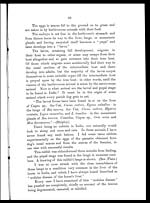Medicine - Veterinary > Civil Veterinary Departments > Indian Civil Veterinary Department memoirs > No. 2 - Collected notes
(245) Page 62
Download files
Individual page:
Thumbnail gallery: Grid view | List view

62
This may be taken as a further proof that canine epis-
taxis is due to anchylostomes, for one can conclude that the
pariah possesses immunity to the poisons excreted by the
anchylostomes in the same way as it acquires immunity to
certain endemic diseases, such as contagious gastro-enteritis
from continual association with the poison or virus, but
immunity to what would be in the case of Linguatula
a mechanical cause of hæmorrhage would be hardly possible.
Symptoms common to European and pariah dogs, and
which are no doubt due to the presence of the Linguatula,
are:—
Intense periodical irritation in the nostrils. Rubbing
with the paw. Severe attacks of sneezing.
After running he will stop suddenly and gasp for
breath; the nostrils seem closed to the exit of air.
The dog makes a great effort at inspiration which takes
place through the nostrils, but expiration is viâ the mouth.
Probably the cold air taken in when running causes the
parasites to shorten and thicken—a common form of move-
ment with them—and this closes the nasal meati.
I have not seen a whole parasite ejected by a fit of
sneezing, but I have frequently examined the nasal mucus
so discharged, and found the eggs.
The anatomy and measurements of the Linguatula
tænioides as found in Lahore agree with those given in all the
works on Parasitology for the European parasite. The
female is 9 to 10 cm. long, 8 to 10 mm. broad anteriorly
and 2 mm. posteriorly. (See Plate.)
The egg measurements, however, vary very considerably.
Instead of being 90 µ long and 70 µ broad, they were,
when examined in fresh nasal mucus from the dog, 126 µ
long and 80 µ wide.
Eggs which had been preserved for some months in
5 per cent. formalin solution were 114 µ long and 76 µ wide.
In six text-books on Parasitology the measurements
are given as 90 µ and 70 µ, and the mistake has probably
been copied from one book to the other, having originated
from counting immature eggs from the uterus of the
parasite, instead of mature eggs from the mucus in the
host's nostril. (See Plate.)
Set display mode to: Large image | Zoom image | Transcription
Images and transcriptions on this page, including medium image downloads, may be used under the Creative Commons Attribution 4.0 International Licence unless otherwise stated. ![]()
| India Papers > Medicine - Veterinary > Civil Veterinary Departments > Indian Civil Veterinary Department memoirs > Collected notes > (245) Page 62 |
|---|
| Permanent URL | https://digital.nls.uk/75512721 |
|---|
| Shelfmark | IP/RA.10. |
|---|---|
| Additional NLS resources: | |



![[Page 61]](https://deriv.nls.uk/dcn4/7551/75512720.4.jpg)
